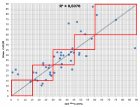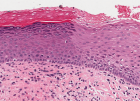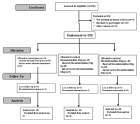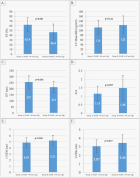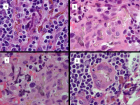Abstract
Review Article
Extremely large hemangioma of the liver: Safety of the expectant management
Subhi Mansour, Sharbel Khouri, Maisa Andraous and Safi Khuri*
Published: 06 September, 2019 | Volume 3 - Issue 2 | Pages: 061-064
Hemangiomas are known as congenital vascular malformations that can affect almost any organ or tissue, with the liver being the most common intra-abdominal organ to be involved. It is well known that hemangiomas are the most common benign tumours of the liver, and develop in about 4-20% of people, mainly young adult females. Recently, due to the dramatic rise in the use of imaging studies for different purposes, a parallel increase in the incidence of these tumours has been noticed. Most liver hemangiomas are small (less than 4cm in diameter), asymptomatic and found incidentally during abdominal operation for other indication or on radiologic studies. Giant liver hemangioma is defined as hemangioma with a diameter of more than 5cm. This unique and uncommon type of haemangioma usually poses therapeutic challenges for the treating physician, especially hepatic surgeons, due to the unclear natural history, and due to the risk of life threatening complications is yet to be established. While it is already proved by several studies that conservative management of giant hepatic hemangioma is safe, it is not known whether observation of the extremely large hepatic hemangioma (tumours larger than 10cm) is safe as well.
The aim of this article is to review the English literature to find out if conservative management of the extremely giant liver hemangioma is safe and can be recommended.
Read Full Article HTML DOI: 10.29328/journal.ascr.1001036 Cite this Article Read Full Article PDF
Keywords:
Extremely large hepatic hemangioma; Conservative management
References
- Maestroni U, Dinale F, Frattini A, Cortellini P. Ureteral hemangioma: A clinical case report. Acta Biomed. 2005; 76: 115-117. PubMed: https://www.ncbi.nlm.nih.gov/pubmed/16350557
- Tait N, Richardson AJ, Muguti G, Little JM. Hepatic cavernous haemangioma: A 10 year review. Aust N Z J Surg. 1992; 62: 521-524. PubMed: https://www.ncbi.nlm.nih.gov/pubmed/1610320
- Choi BY, Nguyen MH. The diagnosis and management of benign hepatic tumors. J Clin Gastroenterol. 2005; 39: 401-412. PubMed: https://www.ncbi.nlm.nih.gov/pubmed/15815209
- Lise M, Feltrin G, Da Pian PP, Miotto D, Pilati PL, et al. Giant cavernous hemangioma: diagnosis and surgical strategies. World J Surg. 1992; 16: 516-20. PubMed: https://www.ncbi.nlm.nih.gov/pubmed/1589990
- Bioulac-Sage P, Laumonier H, Laurent C, Blanc JF, Balabaud C. Benign and malignant vascular tumors of the liver in adults. Semin Liver Dis. 2008; 28: 302-314. PubMed: https://www.ncbi.nlm.nih.gov/pubmed/18814083
- Ketchum WA, Lin-Hurtubise KM, Ochmanek E, Ishihara K, Rice RD. Management of Symptomatic Hepatic "Mega" Hemangioma. Hawaii J Med Public Health. 2019; 78: 128-131. PubMed: https://www.ncbi.nlm.nih.gov/pubmed/30972235
- Zhuang BW, Li W, Chen ZF, Cao CJ, Xie XY, et al. Multiple cavernous hemangiomas of the lung and liver mimicking metastasis: A case report and literature review. Medicine (Baltimore). 2018; 97: e13509. PubMed: https://www.ncbi.nlm.nih.gov/pubmed/30572451
- Farges O, Daradkeh S, Bismuth H. Cavernous hemangiomas of the liver: are there any indications for resection? World J Surg. 1995; 19: 19-24. PubMed: https://www.ncbi.nlm.nih.gov/pubmed/7740805
- Okano H, Shiraki K, Inoue H, Ito T, Yamanaka T, et al. Natural course of cavernous hepatic hemangioma. Oncol Rep. 2001; 8: 411-414. PubMed: https://www.ncbi.nlm.nih.gov/pubmed/11182065
- Pietrabissa A, Giulianotti P, Campatelli A, Di Candio G, Farina F, et al. Management and follow-up of 78 giant haemangiomas of the liver. Br J Surg. 1996; 83: 915-918. PubMed: https://www.ncbi.nlm.nih.gov/pubmed/8813773
- Yoon SS, Charny CK, Fong Y, Jarnagin WR, Schwartz LH, et al. Diagnosis, management, and outcomes of 115 patients with hepatic hemangioma. J Am Coll Surg. 2003; 197: 392-402. PubMed: https://www.ncbi.nlm.nih.gov/pubmed/12946794
- Erdogan GD, Busch OR, Van Delden OM, Bennink RJ, ten Kate FJ, et al. Management of liver hemangiomas according to size and symptoms. J Gastroenterol Hepatol. 2007; 22: 1953-1958. PubMed: https://www.ncbi.nlm.nih.gov/pubmed/17914976
- Hoekstra LT, Bieze M, Erdogan D, Roelofs JJ, Beuers UH, et al. Management of giant liver hemangiomas: An update. Expert Rev Gastroenterol Hepatol. 2013; 7: 263-268. PubMed: https://www.ncbi.nlm.nih.gov/pubmed/23445235
- Schnelldorfer T, Ware AL, Smoot R, Schleck CD, Harmsen WS, et al. Management of giant hemangioma of the liver: resection versus observation. J Am Coll Surg. 2010; 211: 724-730. PubMed: https://www.ncbi.nlm.nih.gov/pubmed/20980175
- Yedibela S, Alibek S, Muller V, Aydin U, Langheinrich M, et al. Management of Hemangioma of the Liver: Surgical Therapy or Observation? World J Surg. 2013; 37: 1303-1312. PubMed: https://www.ncbi.nlm.nih.gov/pubmed/23354918
- Herman P, Costa MLV, Machado MAC, Pugliese V, D'Albuquerque LAC, et al. Management of Hepatic Hemangiomas: A 14-Year Experience. J Gastrointest Surg. 2005; 9: 853-859. PubMed: https://www.ncbi.nlm.nih.gov/pubmed/15985244
- Marcello D, Gregor S, Angelo D, Karl O. The risk of spontaneous rupture of liver hemangiomas: A critical review of the literature. J Hepatobiliary Pancreat Sci. 2011; 18: 797-805. PubMed: https://www.ncbi.nlm.nih.gov/pubmed/21796406
- Giuliante F, Ardito F, Vellone M, Giordano M, Ranucci G, et al. Reappraisal of surgical indications and approach for liver hemangioma: single-center experience on 74 patients. Am J Surg. 2011; 201: 741-748. PubMed: https://www.ncbi.nlm.nih.gov/pubmed/20937504
- Zhang W, Huang ZY, Ke CS, Wu C, Zhang ZW, et al. Surgical Treatment of Giant Liver Hemangioma Larger Than 10?cm: A Single Center's Experience with 86 Patients. Medicine (Baltimore). 2015; 94: e1420. PubMed: https://www.ncbi.nlm.nih.gov/pubmed/26313792
- Bajenaru N, Balaban V, Savulescu F, Campeanu I, Patrascu T. Hepatic hemangioma- review. J Med Life. 2015; 8: 4-11. PubMed: https://www.ncbi.nlm.nih.gov/pubmed/26361504
Figures:

Figure 1
Similar Articles
-
Extremely large hemangioma of the liver: Safety of the expectant managementSubhi Mansour, Sharbel Khouri,Maisa Andraous,Safi Khuri*. Extremely large hemangioma of the liver: Safety of the expectant management. . 2019 doi: 10.29328/journal.ascr.1001036; 3: 061-064
Recently Viewed
-
Follow-up of patients with sarcoidosis in an internal medicine unit from a hospital in Asturias, Spain. Analysis of extrapulmonary manifestationsGómez de la Torre R*,Charca Benavente L,Yllera Gutiérrez C,Rolle V,Colunga Argüelles D. Follow-up of patients with sarcoidosis in an internal medicine unit from a hospital in Asturias, Spain. Analysis of extrapulmonary manifestations. J Child Adult Vaccines Immunol. 2022: doi: 10.29328/journal.jcavi.1001009; 6: 005-007
-
Application of Bioactive Cotton Packages for Packaging and Storage of Grains Using Aromatic ComponentsRefaie R,Zaghloul S,Elbisi MK,Hamdy A Shaaban*. Application of Bioactive Cotton Packages for Packaging and Storage of Grains Using Aromatic Components. Arch Food Nutr Sci. 2025: doi: 10.29328/journal.afns.1001064; 9: 011-019
-
Assessment of Albino Beech Supremacy to Pigmented Beech Proves to Be A Better Environmental Condition BioindicatorRenata Gagić-Serdar*,Miroslava Marković,Ljubinko Rakonjac,Goran Češljar,Bojan Konatar. Assessment of Albino Beech Supremacy to Pigmented Beech Proves to Be A Better Environmental Condition Bioindicator. Insights Biol Med. 2025: doi: 10.29328/journal.ibm.1001031; 9: 009-015.
-
Green Synthesis of Citrus sinensis Peel (Orange Peel) Extract Silver Nanoparticle and its Various Pharmacological ActivitiesJ Bagyalakshmi,M Prathiksha. Green Synthesis of Citrus sinensis Peel (Orange Peel) Extract Silver Nanoparticle and its Various Pharmacological Activities. Arch Pharm Pharma Sci. 2025: doi: 10.29328/journal.apps.1001065; 9: 009-013
-
The Accuracy of pHH3 in Meningioma Grading: A Single Institution StudyMansouri Nada1, Yaiche Rahma*, Takout Khouloud, Gargouri Faten, Tlili Karima, Rachdi Mohamed Amine, Ammar Hichem, Yedeas Dahmani, Radhouane Khaled, Chkili Ridha, Msakni Issam, Laabidi Besma. The Accuracy of pHH3 in Meningioma Grading: A Single Institution Study. Arch Pathol Clin Res. 2024: doi: 10.29328/journal.apcr.1001041; 8: 006-011
Most Viewed
-
Feasibility study of magnetic sensing for detecting single-neuron action potentialsDenis Tonini,Kai Wu,Renata Saha,Jian-Ping Wang*. Feasibility study of magnetic sensing for detecting single-neuron action potentials. Ann Biomed Sci Eng. 2022 doi: 10.29328/journal.abse.1001018; 6: 019-029
-
Evaluation of In vitro and Ex vivo Models for Studying the Effectiveness of Vaginal Drug Systems in Controlling Microbe Infections: A Systematic ReviewMohammad Hossein Karami*, Majid Abdouss*, Mandana Karami. Evaluation of In vitro and Ex vivo Models for Studying the Effectiveness of Vaginal Drug Systems in Controlling Microbe Infections: A Systematic Review. Clin J Obstet Gynecol. 2023 doi: 10.29328/journal.cjog.1001151; 6: 201-215
-
Prospective Coronavirus Liver Effects: Available KnowledgeAvishek Mandal*. Prospective Coronavirus Liver Effects: Available Knowledge. Ann Clin Gastroenterol Hepatol. 2023 doi: 10.29328/journal.acgh.1001039; 7: 001-010
-
Causal Link between Human Blood Metabolites and Asthma: An Investigation Using Mendelian RandomizationYong-Qing Zhu, Xiao-Yan Meng, Jing-Hua Yang*. Causal Link between Human Blood Metabolites and Asthma: An Investigation Using Mendelian Randomization. Arch Asthma Allergy Immunol. 2023 doi: 10.29328/journal.aaai.1001032; 7: 012-022
-
An algorithm to safely manage oral food challenge in an office-based setting for children with multiple food allergiesNathalie Cottel,Aïcha Dieme,Véronique Orcel,Yannick Chantran,Mélisande Bourgoin-Heck,Jocelyne Just. An algorithm to safely manage oral food challenge in an office-based setting for children with multiple food allergies. Arch Asthma Allergy Immunol. 2021 doi: 10.29328/journal.aaai.1001027; 5: 030-037

HSPI: We're glad you're here. Please click "create a new Query" if you are a new visitor to our website and need further information from us.
If you are already a member of our network and need to keep track of any developments regarding a question you have already submitted, click "take me to my Query."






